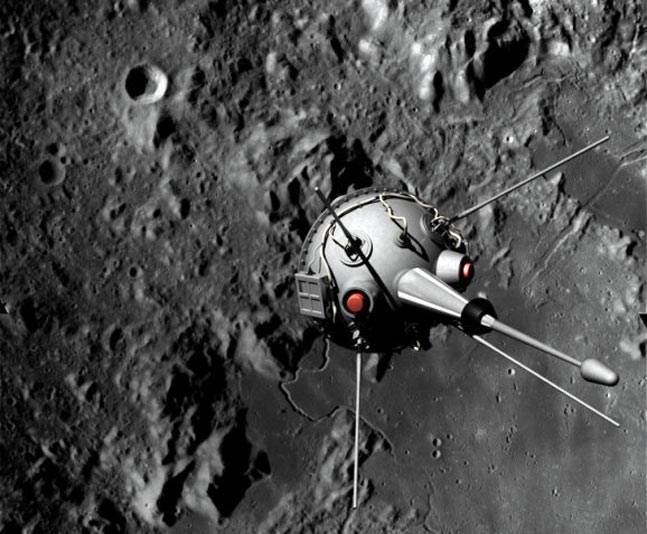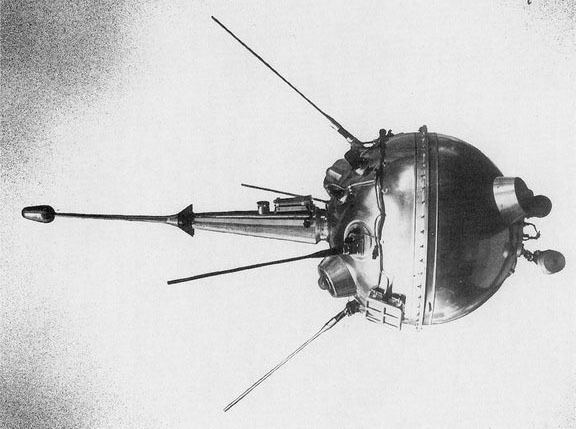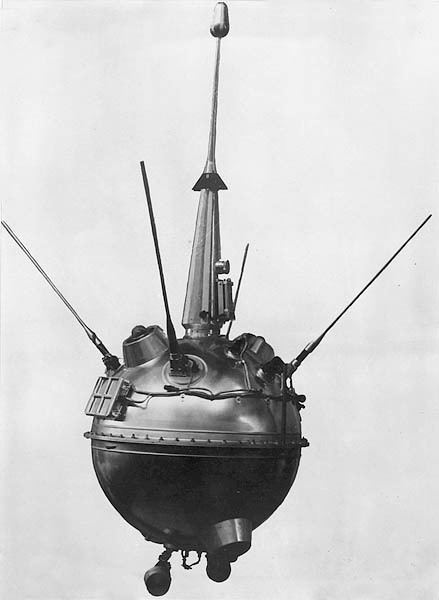Mission type Lunar impactor Harvard designation 1959 Xi 1 Launch mass 390.2 kg | SATCAT no. 114 Launch date 12 September 1959 | |
 | ||
Impact date September 13, 1959, 21:02:24 (1959-09-13UTC21:02:25) UTC Manufacturer S. P. Korolev Rocket and Space Corporation Energia Similar Luna 1, Luna 3, Luna 4, Luna 10, Luna 17 | ||
1959 luna 2 ussr
Luna 2 (E-1A series) or Lunik 2 was the second of the Soviet Union's Luna programme spacecraft launched to the Moon. It was the first spacecraft to reach the surface of the Moon, and the first man-made object to land on another celestial body. On September 13, 1959, it successfully impacted east of Mare Imbrium near the craters Aristides, Archimedes, and Autolycus.
Contents
- 1959 luna 2 ussr
- Luna 2 orbiter space flight simulator 2010
- Impact
- Experiments
- Van Allen Radiation Belt
- USSR pennants
- References

Launch was scheduled for September 9, but the Blok I core stage was shut down after it failed to reach full thrust at ignition. The booster was removed from the pad and replaced by a different vehicle, delaying the flight by three days. Luna 2, like Luna 1, took a direct path to the Moon, a journey of around 36 hours. The Earth-Moon gravitational system forced it to follow a curved trajectory, and launch had to occur from the side of the Earth opposite the Moon. Luna 2 hit the Moon about 800 kilometres from the centre of the visible disk on 1959 September 13 at 21:02:24.

Luna 2 was similar in design to Luna 1, a spherical spacecraft with protruding antennas and instrument parts. The instrumentation was also similar to Luna 1, including scintillation counters, geiger counters, a magnetometer, Cherenkov detectors, and micrometeorite detectors. There were no propulsion systems on Luna 2 itself.

Once Luna 2 was split from its upper stage it started transmitting information back to earth using three different transmitters. These transmitters were providing precise information on its course allowing scientist to calculate that Luna 2 would hit its mark on the moon around 00:05 on September 14. In order to be able to get a visual of Luna 2 from Earth on September 13 it released a vapor cloud that would expand into a 650 km diameter that would be seen by observatories in Alma Ata, Byurakan, Abastuma, Tbilisi, and Stalinabad. This vapor cloud also acted as an experiment to see how the sodium gas would act in a vacuum and zero gravity.
The last stage of the rocket that carried Luna 2 did not carry any type of tracking device so there was uncertainty as to where it landed, but it did hit the Moon surface about 30 minutes after Luna 2 hit.

Luna 2 orbiter space flight simulator 2010
Impact

For a time, Americans were starting to believe that they were making progress in the Space Race and that although the Soviets might have had larger rockets, the United States had better guidance systems. This myth was busted after the Soviets were able to crash Luna 2 onto the Moon. At that time the closest Americans had come to the Moon was about 37,000 miles (60,000 km) with Pioneer 4. Khrushchev, on his only visit to the U.S., gave president Eisenhower a replica of the Soviet pennants that Luna 2 had just placed onto the lunar surface. Luna 2 and its predecessors all came to be used throughout the USSR and around the world as pro-communist propaganda. Donald W. Cox explains this in his book The Space Race, “Although the Sputniks and Luniks did not themselves provide better cars, refrigerators, color TV sets, and homes for the peasants and laborers of the Soviet Union and her satellite states, they did evoke added inspiration for the earth bound followers of the communist way of life helping to take their minds off shortages of consumer goods. The people were spurred on to work just a little harder for the glorious motherland and to outstrip the west in the less dramatic and more basic things of life, like coal and steel production.” Although Luna 2 was a success for the Soviets, it also helped the U.S. by starting a trend of crash landing. It would eventually lead to the U.S.-made Rangers which would go on to also crash land on the Moon in exactly the same way. Crash landing proved useful even after soft landing was mastered. NASA used crash landings to test whether Moon craters contained ice by crashing space probes into craters and testing the debris that got thrown out.
Experiments
Luna 2 carried 5 different instruments to conduct various tests while it was on its way to the Moon. The scintillation counters would be used to measure any ionizing radiation; the Cherenkov radiation detectors would be measuring for electromagnetic radiation caused by charged particles. “The Geiger Counter carried on Luna 2 had the primary scientific objective of determining the electron spectrum of the outer radiation belt. The instrument consisted of three STS-5 gas-discharge counters mounted on the outside of the hermetically sealed container, and would be powered by a 360 V battery”. The last instrument on Luna 2 was, “a three component fluxgate magnetometer similar to that used on Luna 1 but with the dynamic range reduced by a factor of 4 to -750 to +750 gammas so that the quantization uncertainty was -12 to +12 gammas.” Together the devices were searching for lunar magnetic and radiation fields similar to the Van Allen radiation belt around earth sending information about once every minute until its last transmission which came about 55 km away from the lunar surface. Although it did prove previous measurements of the Van Allen radiation belts that were taken from Luna 1 around the Earth, it was not able to detect any type of radiation belts around the moon. Because of claims that information received from Luna 1 was fake, as soon as the scientists of Luna 2 starting receiving transmissions they sent out the intended time of impact, and the transmission and trajectory details. Even though Soviet scientists gave all this information Americans were still skeptical until Bernard Lovell was able to prove that the radio signal was coming from Luna 2 by showing the Doppler shift from its transmissions. After this no one seemed to question the validity of the Soviets.
Van Allen Radiation Belt
Luna 2 showed time variations in the electron flux and energy spectrum in the Van Allen radiation belt.
USSR pennants
The spacecraft also carried Soviet pennants. Two of them, located in the spacecraft, were sphere-shaped, with the surface covered by identical pentagonal elements. In the center was an explosive charge designed to shatter the sphere, sending the pentagonal shields in all directions. Each pentagonal element was made of stainless steel and had the USSR Coat of Arms and the Cyrillic letters СССР ("USSR") engraved on one side, and the words СССР январь 1959 ("USSR January 1959") on the other side. They most likely vaporized on impact, however. The third pennant was located in the last stage of the Luna 2 rocket, which collided with the moon's surface 30 minutes after the spacecraft did. It was a capsule filled with liquid, with aluminium strips placed into it. On each of these strips the USSR Coat of Arms, the words 1959 январь ("1959 January"), and the words СОЮЗ СОВЕТСКИХ СОЦИАЛИСТИЧЕСКИХ РЕСПУБЛИК (English: "Union of Soviet Socialist Republics") were engraved.
On September 15, 1959, the premier of the Soviet Union, Nikita Khrushchev, presented the American president Dwight D. Eisenhower with a copy of the spherical pennant as a gift. That sphere is kept at the Eisenhower Presidential Library and Museum in Abilene, Kansas. The only other known copy of the spherical pennant is located at the Kansas Cosmosphere in Hutchinson, Kansas.
